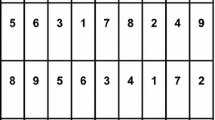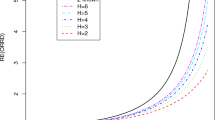Abstract
Agricultural experiments are often laid out in a rectangle in 3–5 replicates. Is it better to use a standard randomized complete-block design in rows, or a complete-block design in rows but with restricted randomization, or an efficient row-column design? These approaches differ in the variance of the estimator of a difference between two treatments, and in the bias of the estimator of that variance, as well as in the mechanics of constructing the design and analyzing the data. I conclude that when intra-column correlations are high then the row-column design is best but that when they are moderate the best procedure is to use an improved version of restricted randomization, which gives an unbiased estimator of the average variance in the single experiment performed.
Similar content being viewed by others
References
Bailey, R. A. (1981), “A Unified Approach to Design of Experiments,” Journal of the Royal Statistical Society, Series A, 144, 214–223.
— (1983), “Restricted Randomization,” Biometrika, 70, 183–198.
— (1985a), “Restricted Randomization Versus Blocking,” International Statistical Review, 53, 171–182.
Bailey, R. A. (1985b), “Restricted Randomization for Neighbour-Balanced Designs,” Statistics & Decisions, Supplement 2, 237–248.
— (1987), “One-Way Blocks in Two-Way Layouts,” Biometrika, 74, 27–32.
— (1991), “Strata for Randomized Experiments (with discussion),” Journal of the Royal Statistical Society, Series B, 53, 27–78.
Bailey, R. A., and Nelson, P. R. (2003), “Hadamard Randomization: A Valid Restriction of Random Permuted Blocks,” Biometrical Journal, 45, 554–560.
Bailey, R. A., and Rowley, C. A. (1987), “Valid Randomization,” Proceedings of the Royal Society of London, Series A, 410, 105–124.
Bowman, D. T. (2000), “TFPlan: Software for Restricted Randomization in Field Plot Design,” Agronomy Journal, 92, 1276–1278.
Caliński, T., and Kageyama, S. (2000), Block Designs: A Randomization Approach. Volume I: Analysis, New York: Springer.
Cheng, C.-S. (1978), “Optimality of Certain Asymmetrical Experimental Designs,” Annals of Statistics, 6, 1239–1261.
Cheng, C.-S., and Bailey, R. A. (1991), “Optimality of Some Two-Associate-Class Partially Balanced Incomplete-Block Designs,” Annals of Statistics, 19, 1667–1671.
Cox, D. R. (1958), Planning of Experiments, New York: John Wiley & Sons.
Federer, W. T. (1955), Experimental Design, New York: Macmillan.
Fisher, R. A. (1935), Design of Experiments, Edinburgh: Oliver and Boyd.
Gilmour, S. G., and Goos, P. (2009), “Analysis of Data From Nonorthogonal Multi-Stratum Designs,” Journal of the Royal Statistical Society, Series C, 58, 467–484.
Grundy, P. M., and Healy, M. J. R. (1950), “Restricted Randomization and Quasi-Latin Squares,” Journal of the Royal Statistical Society, Series B, 12, 286–291.
Hall, P. (1935), “On Representatives of Subsets,” Journal of the London Mathematical Society, 10, 26–30.
John, J. A., and Mitchell, T. J. (1977), “Optimal Incomplete Block Designs,” Journal of the Royal Statistical Society, Series B, 39, 39–43.
Kempthorne, O. (1961), “Chapter VIII: Constrained Randomization,” in Analysis of Variance Procedures, ARL149, eds. O. Kempthorne, G. Zyskind, S. Addelman, T. N. Throckmorton, and R. F. White, Ohio: Aeronautical Research Lab Office of Aerospace Research, U.S. Air Force, Wright-Patterson Air Force Base, pp. 190–202.
Kshirsagar, A. M. (1958), “A Note on Incomplete Block Designs,” Annals of Mathematical Statistics, 29, 907–910.
Monod, H., Azaïs, J.-M., and Bailey, R. A. (1996), “Valid Randomisation for the First Difference Analysis,” Australian Journal of Statistics, 33, 91–106.
Monod, H., and Bailey, R. A. (1993), “Valid Restricted Randomization for Unbalanced Designs,” Journal of the Royal Statistical Society, Series B, 55, 237–251.
Nelder, J. A. (1965), “The Analysis of Randomized Experiments with Orthogonal Block Structure. I. Block Structure and the Null Analysis of Variance,” Proceedings of the Royal Society of London, Series A, 283, 147–162.
— (1968), “The Combination of Information in Generally Balanced Designs,” Journal of the Royal Statistical Society, Series B, 30, 303–311.
Patterson, H. D., and Thompson, R. (1971), “Recovery of Inter-Block Information When Block Sizes Are Unequal,” Biometrika, 58, 545–554.
Shah, K., and Sinha, B. K. (1989), Theory of Optimal Designs, New York: Springer.
Speed, T. P. (1987), “What Is an Analysis of Variance?,” Annals of Statistics, 15, 885–910.
Whitaker, D. E. R., Williams, E. R., and John, J. A. (2006), “CycDesigN: A Package for the Computer Generation Of Experimental Designs,” http://cycdesign.co.nz.
White, L. V., and Welch, W. J. (1981), “A Method for Constructing Valid Restricted Randomization Schemes Using the Theory of D-Optimal Design of Experiments,” Journal of the Royal Statistical Society, Series B, 43, 167–172.
Yates, F. (1939), “The Comparative Advantages of Systematic and Randomized Arrangements in the Design of Agricultural and Biological Experiments,” Biometrika, 30, 440–466.
— (1948), “Contribution to the Discussion of ‘The Validity of Comparative Experiments’ by F. J. Anscombe,” Journal of the Royal Statistical Society, Series A, 111, 204–205.
Youden, W. J. (1972), “Randomization and Experimentation,” Technometrics, 14, 13–22.
Author information
Authors and Affiliations
Corresponding author
Rights and permissions
About this article
Cite this article
Bailey, R.A. Experiments in Rectangular Areas: Design and Randomization. JABES 17, 176–191 (2012). https://doi.org/10.1007/s13253-011-0082-6
Published:
Issue Date:
DOI: https://doi.org/10.1007/s13253-011-0082-6




